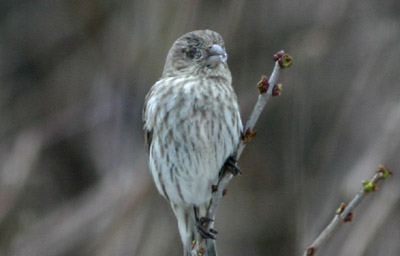
I spotted the mangy female House Finch featured above at Ann’s feeders last week. Before you panic, this poor wretch doesn’t seem to be suffering from H5N1 poultry flu or leprosy. No, what is afflicting this unfortunate Carpodacus mexicanus is most likely Mycoplasma gallisepticum, otherwise known as mycoplasmal conjunctivitis, house finch conjunctivitis, or simply house finch eye disease.
Mycoplasma gallisepticum is a bacterium that primarily affects house finches, but has been encountered in other bird species, predominantly other finches. Don’t worry; this ailment is avian only. Mycoplasmal conjunctivitis may be recognized as an eye disease, but is actually a respiratory infection that causes swollen sinuses, runny noses, coughing, sneezing, and wheezing. The attending swollen, runny, crusty, inflamed eyes are a giveaway, though.
Mycoplasma gallisepticum infection is not usually, of itself, fatal. However, many birds afflicted with MG die of predation or starvation related to their diminished faculties and field of vision. It is contagious and has spread throughout most of eastern North America from Quebec to Florida. The fact that this territory represents the invasive range of this western North American species is not ironic, but instructive. Invasive species always contend with unanticipated environmental hazards. Eastern house finches are particularly vulnerable because they are all descended from a small group of released birds and thus lack robust genetic diversity.
Mycoplasmal conjunctivitis was once considered a potential threat to the entire eastern house finch population. The Cornell Lab of Ornithology, always on the case, assures us that the situation is not as dire as it once was:
House Finch Disease Survey data tell us that the disease has decreased from epidemic proportions and is now restricted to a smaller percentage of the population. We estimate that 5% to 10% of the eastern House Finch population has this disease and that the dramatic spread that occurred a few years ago has equilibrated. This means that it is still an important and harmful disease, but that House Finch populations are not currently at extreme risk of wide-spread population declines.
What should you do if you see a diseased house finch? Well, first off, don’t freak out and destroy the local farmer’s poultry stock. This is not avian influenza and you are not in peril! The rational thing to do, assuming you have a bird feeder, is to clean your feeder immediately with a 10% bleach solution solution (1 part bleach and 9 parts water). In fact, you should be doing that regularly anyway, which is easy for a city boy like me to say. There are more steps you should take to offer your winter guests, at least those of the avian persuasion, protection from Mycoplasma gallisepticum. Visit the Cornell Lab to read their suggestions.













I have a male House Finch just like this. My dogs were trying to catch him and I interceded on his behalf. I have him in a small glass aquarium with a lid. He is eating Parakeet food and getting lots of rest. How soon should this clear up and will he be ok to release back into the wild once he recovers? Woull like to know if I did the right thing.